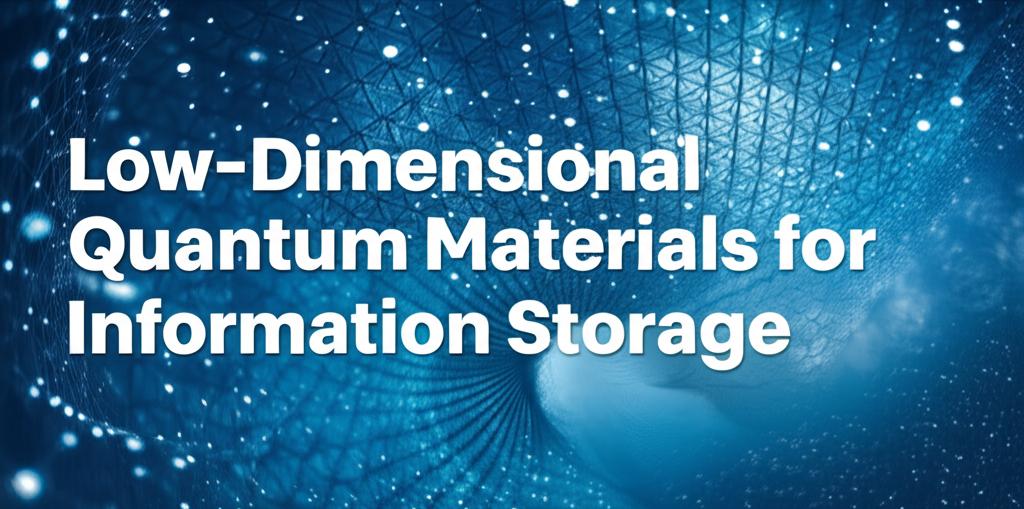The quest for faster, denser, and more energy-efficient information storage solutions is driving intense research into new materials and device concepts. Low-dimensional quantum materials, including two-dimensional (2D) sheets, one-dimensional (1D) nanowires, and zero-dimensional (0D) quantum dots, are emerging as highly promising candidates due to their unique properties derived from quantum mechanics and nanoscale confinement.
These materials, often just atoms thick, exhibit distinct electronic, magnetic, optical, and mechanical characteristics compared to their bulk counterparts. Quantum effects like confinement, unique band structures, and properties related to electron spin become dominant, offering pathways to overcome the limitations of current silicon-based technologies.
Two-Dimensional Materials: A Versatile PlatformAtomically thin 2D materials like graphene, transition metal dichalcogenides (TMDs such as MoS₂, WSe₂, In₂Se₃), hexagonal boron nitride (hBN), and MXenes are at the forefront of this research. Their atomically smooth surfaces, diverse electronic properties (ranging from metallic to semiconducting to insulating), and compatibility with heterostructure engineering make them ideal building blocks for next-generation memory.
- Spintronics and MRAM: Magnetoresistive Random Access Memory (MRAM) utilizes electron spin to store information, offering non-volatility (retaining data without power), high speed, and endurance. 2D materials are poised to significantly enhance MRAM performance. Their atomically sharp interfaces, unique crystal symmetries, and potential for proximity effects can lead to more efficient spin manipulation and transport, potentially using mechanisms like Spin Transfer Torque (STT) or Spin-Orbit Coupling (SOC). Research focuses on integrating 2D materials into MRAM cells to reduce power consumption and improve scalability for applications in IoT, automotive, and embedded memory. Projects like the EU's Graphene Flagship and 2DSPIN-TECH are actively exploring these possibilities.
- Resistive Switching Memory (RRAM): RRAM devices store data by changing their electrical resistance. 2D materials and their nanocomposites are being used as the active switching layers. These devices demonstrate advantages like fast switching speeds (sub-10 ns), low power consumption, tunable switching voltages, high endurance (millions of cycles), and potential for mechanical flexibility, making them suitable for wearable electronics.
- Ferroelectric Memory: Certain 2D materials, like α-In₂Se₃, possess intrinsic ferroelectricity. This property can be harnessed to create non-volatile memory devices with extremely fast programming speeds (tens of nanoseconds), large memory windows, and good data retention.
- Quantum Information Storage: Beyond classical bits, low-dimensional materials offer avenues for quantum information. Researchers have identified defects (color centers) in 2D hexagonal boron nitride that can emit single photons and whose quantum spin state can be manipulated using light, even at room temperature. This opens possibilities for using such materials as quantum memories – essential components for future quantum communication networks and potentially quantum computing.
Quantum dots (QDs), nanoscale semiconductor particles, exhibit quantum confinement effects that give them size-tunable electronic and optical properties. In information storage, they are explored as:
- Charge Trapping Centers: When embedded within insulating layers (often organic polymers), QDs can act as nanoscale charge traps. The trapping and de-trapping of charges alter the device's resistance, enabling RRAM functionality.
- Potential Quantum Bits: The distinct quantum states within QDs make them candidates for building qubits, the fundamental units of quantum computation, although significant hurdles remain for scalability and stability.
- Data Storage: Some research explores the magnetic properties of doped QDs for potential high-density data storage applications.
A powerful strategy involves stacking different low-dimensional materials to create van der Waals heterostructures. These engineered structures combine the properties of their constituent layers, leading to emergent phenomena and enhanced device performance. Atomically sharp interfaces between layers are crucial for efficient operation in devices like floating gate memories built from 2D heterostructures, offering ultra-fast programming times. Combining 2D ferromagnetic and ferroelectric materials allows for voltage control of magnetic states, paving the way for ultra-low-power spintronic memory.
Future OutlookLow-dimensional quantum materials offer a revolutionary platform for information storage, promising devices that are faster, smaller, less power-hungry, and potentially flexible. While significant progress has been made in understanding fundamental properties and demonstrating proof-of-concept devices, challenges remain in large-scale, high-quality material synthesis, precise heterostructure fabrication, interface control, and integration with existing manufacturing processes. Continued research at the intersection of materials science, physics, and engineering is crucial to unlock the full potential of these materials and realize next-generation memory technologies for advanced computing, artificial intelligence, and quantum information systems.

